You can't manage what you can't measure. This is especially true when every PSP speaks a different data language.
Enterprise merchants process millions of transactions across multiple payment service providers, yet most struggle with a fundamental challenge: their payment analytics live in silos.
Picture this: your finance team opens Stripe's dashboard and sees a 4.2% decline rate for European transactions. Meanwhile, Adyen reports 3.8% for the same region, and your regional acquirer in Germany shows 5.1%. Which number is accurate? More importantly, which PSP is actually performing better when you account for transaction mix, timing differences, and currency variations?
Every PSP dashboard shows different metrics. Fields don't match. Timeframes vary. What should be your single source of truth becomes a collection of conflicting reports that slow decisions and hide revenue opportunities.
This fragmentation creates a ripple effect across your entire organization. Finance teams spend weeks reconciling data that should take minutes. Payment teams miss decline spikes until customers complain. Product teams can't pinpoint why conversion dropped in specific regions. Meanwhile, your competitors with unified analytics are already optimizing revenue.
What are unified payment analytics?
Relying on fragmented data forces merchants into daily dashboard hopping. Log into Stripe to check yesterday's performance. Switch to Adyen for European metrics. Open your regional acquirer's portal for Asian transactions. By the time you've gathered everything, the data is already hours old and formatted differently across each platform.
When one payment data interface defines "acceptance rate" differently than another, your optimization decisions become guesswork.
Unified analytics transform scattered, PSP-specific data into normalized, real-time insights across all providers and regions. Instead of opening five different payment analytics interfaces to understand performance, a unified analytics dashboard integrates data and applies standardized definitions across providers to create a single, harmonized view. Transaction-level data flows from every PSP, acquirer, and gateway into a single system that speaks the same language across all of your payment methods.
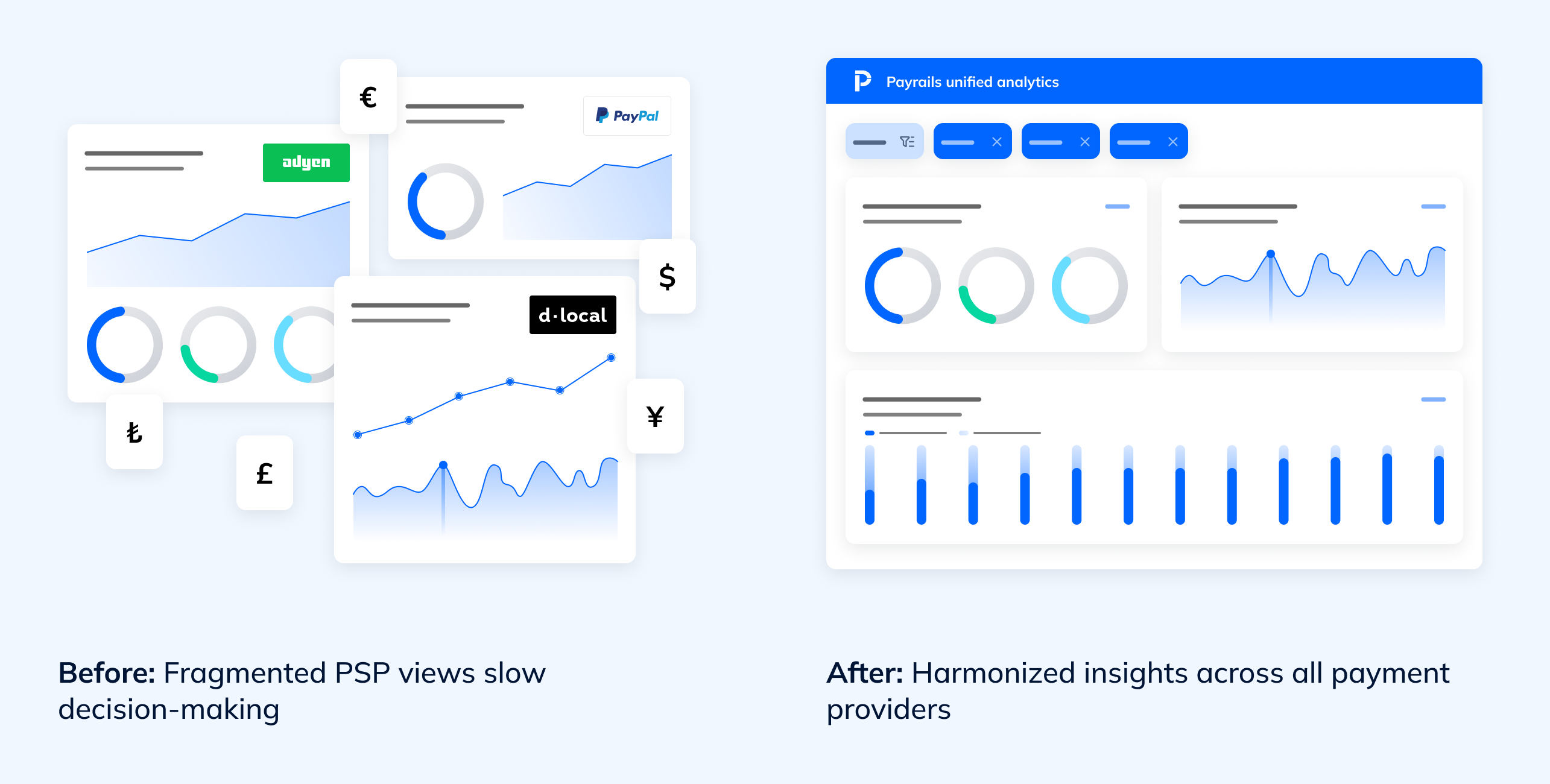
Whether you're processing through Stripe, Adyen, and Checkout.com simultaneously, or routing through regional acquirers across 15 countries, the platform normalizes every transaction into consistent, comparable metrics.
The cost of staying fragmented
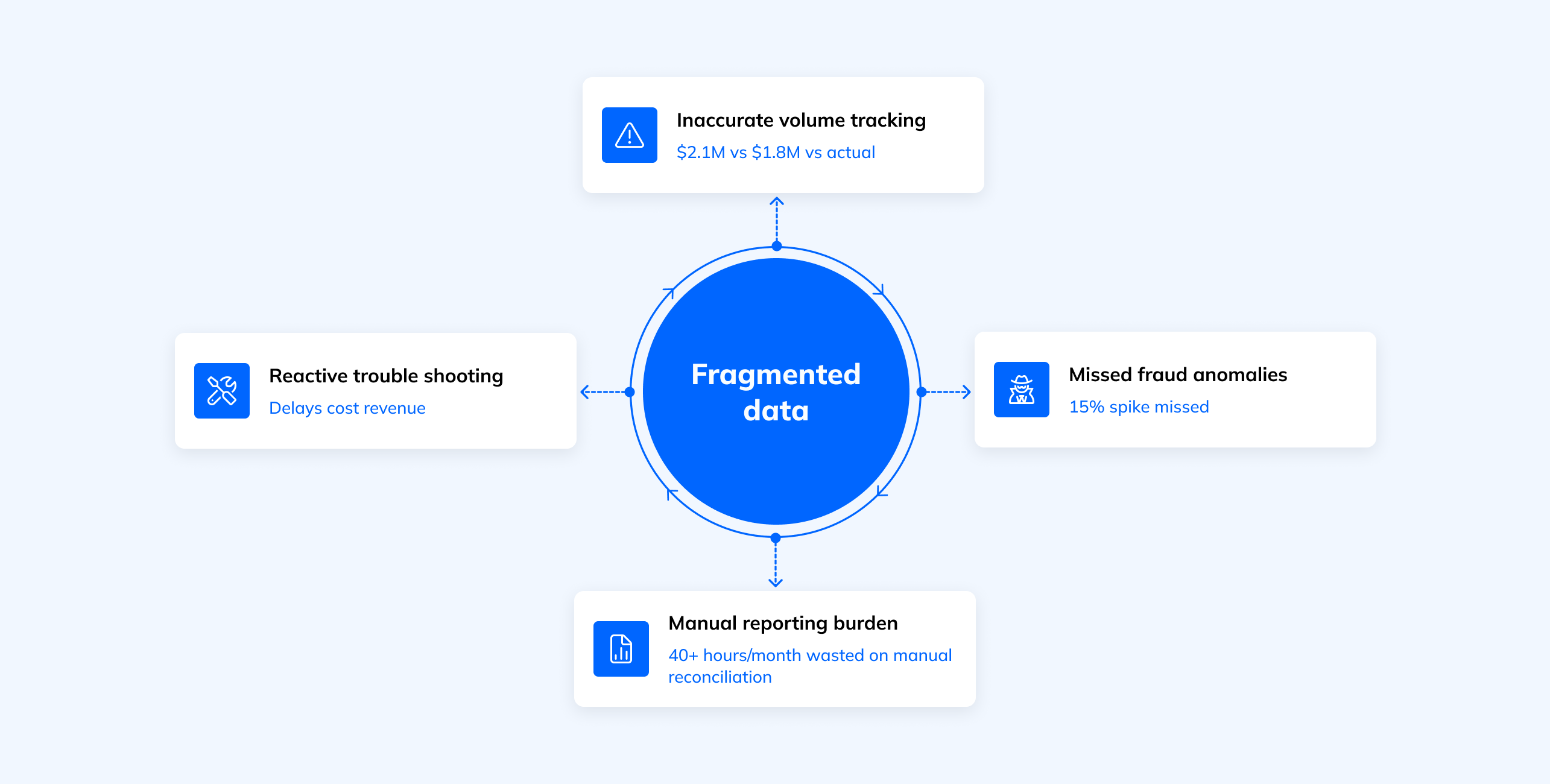
Relying on native PSP dashboards creates expensive blind spots. Fragmented payment data creates measurable problems that impact revenue and operational efficiency:
- Inaccurate total payment volume tracking: PSP A reports $2.1M processed, PSP B shows $1.8M, but your actual total payment volume differs from both. Without unified analytics, you're making expansion decisions on unreliable numbers. When your CFO asks about payment costs as a percentage of revenue, the answer becomes a week-long data reconciliation project.
- Missed anomalies in fraud rate and declines: A 15% spike in fraud rate on one PSP might get buried in daily noise. By the time you notice, you've lost revenue and damaged approval rates with issuers. The pattern might be isolated to specific card types or regions – an insight that's impossible to detect when each PSP shows only its slice of your transaction data.
- Manual reporting burns resources: Finance teams become data janitors, spending hours formatting reports instead of analyzing performance. What should be automated insights instead become expensive overhead. The monthly board report becomes a dreaded multi-day reconciliation project instead of a simple export.
- Reactive troubleshooting delays fixes: When acceptance rates drop, fragmented data can make root cause analysis take days instead of minutes. Revenue bleeds while teams hunt through different dashboards for answers. Is the decline spike related to a specific issuer? A particular transaction amount? Without unified data, every question requires a separate investigation.
Approximately 80 to 90% of payment failures are classified as soft declines, typically caused by minor issues that could be detected earlier with proper analytics. Without the ability to benchmark performance across providers, these patterns would otherwise remain invisible.
Up to 1/3 of shoppers in some markets will abandon their purchase if the payment does not go through on the first try, representing millions of dollars in potential lost sales from soft declines. Unified analytics help businesses to recover more lost transactions and maximize revenue by providing a birds-eye view of performance across regions and payments providers.
Key analytics use cases that drive results
By offering a real-time benchmark of payment performance, unified analytics enable merchants to move from reactive troubleshooting to proactive payment optimization strategies.
Fraud rate monitoring with real-time analytics
Automated anomaly detection catches fraud rate spikes within minutes, not days. Real-time alerts enable immediate response when fraud rates increase significantly, preventing additional losses. Customized reports help merchants identify and resolve payment processing errors, gaining insights into declined transactions and enhancing payment success rates.
Tracking acceptance rate across PSPs
On average, enterprise merchants work with four or more payment processors, making standardized comparison essential for optimization. One Payrails merchant discovered performance patterns that led to a 6% increase in payment authorizations, demonstrating the power of cross-border payment analytics.
PSP performance benchmarking
Rank providers by cost per transaction, approval rates, and dispute ratios using standardized data. Payrails enables merchants to analyze payment data across diverse criteria like country, currency, and issuer bank, helping merchants replace gut feelings with numbers and choose the most cost-effective PSPs.
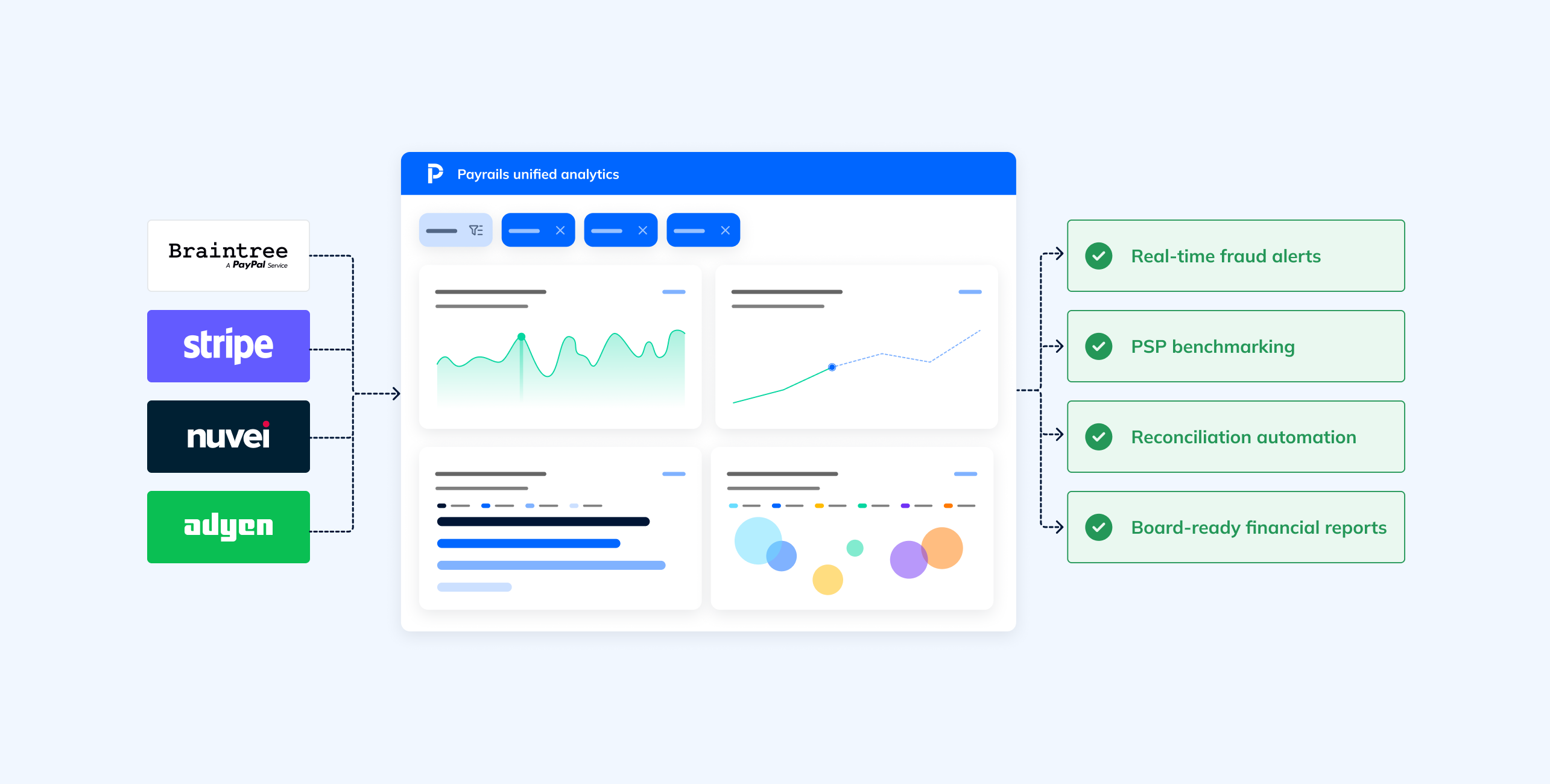
Automated reconciliation insights
Unified analytics help merchants automatically identify discrepancies, flag missing transactions, and generate finance-ready reports. What used to take 40 hours now takes 4 clicks. Payrails payment reconciliation automatically identifies mismatches, saving finance teams significant manual effort.
Recovery opportunity identification
With proper analytics, merchants can identify that up to 23% of declined transactions can be recovered through specific retry logic – insight that remains invisible in fragmented payment data systems.
See how Preply automated reconciliation and cut payment costs using unified analytics
Value for every team
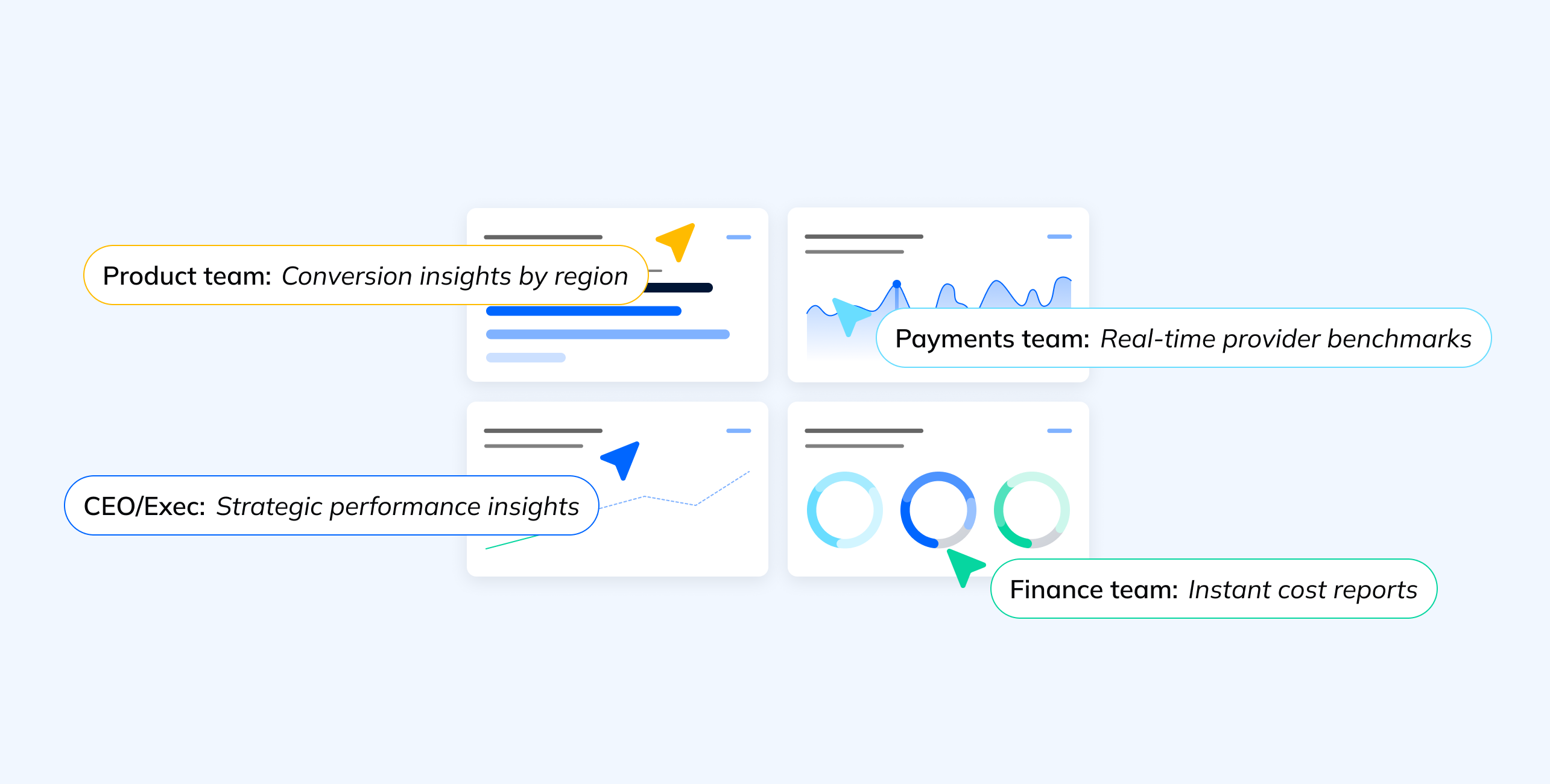
When strategy moves faster, revenue follows. Unified analytics unlock cross-functional wins by making it easier for every team to work from the same dataset.
Finance teams gain cost control
Finance teams often become the reluctant owners of payment data reconciliation, spending countless hours trying to make sense of conflicting PSP reports. With unified analytics, the monthly close process transforms from a multi-week ordeal into an automated workflow. When the CFO asks about payment costs in specific markets, the answer is immediately available.
Payment teams get performance clarity
Payment teams no longer need to maintain separate spreadsheets tracking PSP performance across different metrics and timeframes. Unified analytics provide real-time benchmarking that reveals which payment providers perform best in which specific scenarios. The data granularity enables sophisticated fallback strategies based on real performance patterns rather than assumptions.
Product teams see conversion impact
Product teams often struggle to understand the relationship between checkout design decisions and payment success rates. Unified analytics help merchants bridge this gap by connecting front-end conversion metrics with backend payment performance. When conversion drops in a specific market, teams can immediately identify whether the issue stems from payment method availability, acceptance rates, or user experience friction.
CFO and executive leadership get strategic visibility
Executive leadership gains the strategic payment visibility needed for informed business decisions. Market expansion discussions become data-driven conversations about payment readiness and cost implications. Unified analytics transforms payments from a technical infrastructure concern into a strategic business lever.
Why Payrails: Architecture and advantage
Building unified analytics internally often becomes a multi-quarter engineering project that diverts resources from core business initiatives. Payrails eliminates this complexity by providing enterprise-grade payment analytics infrastructure that is ready to deploy in a matter of weeks.
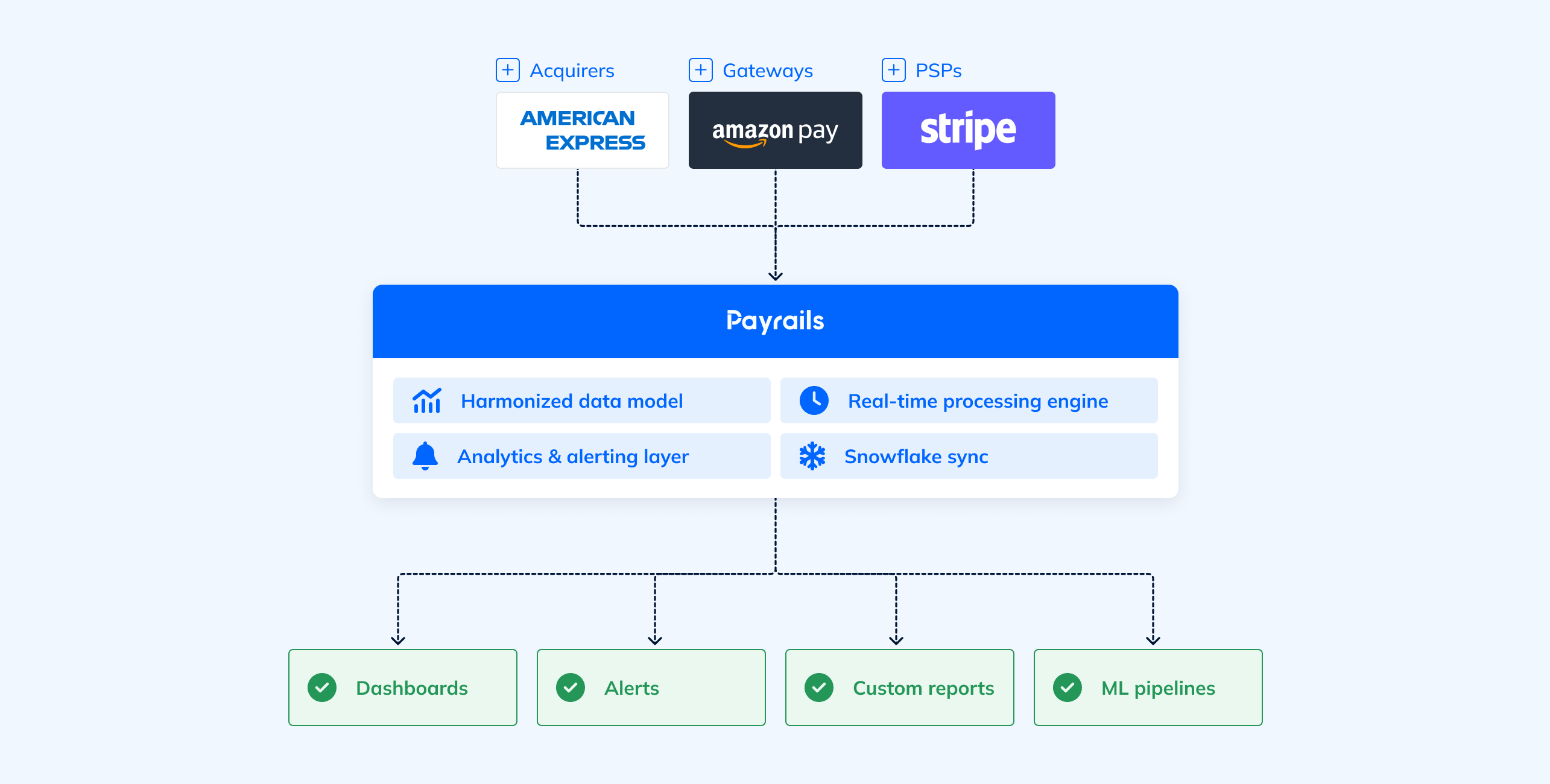
Our platform handles the technical complexity of data normalization, real-time processing, and cross-PSP integration, allowing merchants to focus on optimization rather than infrastructure.
Key capabilities include:
- Harmonized data model: Every transaction follows the same schema, regardless of source PSP. Compare metrics across providers using identical definitions and timeframes. This standardization extends beyond basic fields to include complex calculations like authorization rates, dispute ratios, and cost per transaction – ensuring apple-to-apple comparisons across your entire payment stack.
- Real-time streaming: Real-time data processing means that revenue protection happens instantly, not in hours. Anomalies get detected immediately, not in overnight batch runs. Our platform processes data in near real-time, handling millions of transactions daily while maintaining consistently low latency, ensuring alerts trigger when intervention can still prevent revenue loss.
- Snowflake warehouse share: Your data stays in your environment. Payrails syncs normalized transaction data directly to your Snowflake instance for integration with existing analytics tools. This architecture ensures data governance compliance while enabling seamless integration with business intelligence platforms, machine learning pipelines, and custom reporting tools.
- Payment analytics dashboard with alerting: Monitor acceptance rates, fraud patterns, and cost metrics through live dashboards. Set alerts for anomalies that need immediate attention. Customizable reporting ensures teams get insights into declined transactions and enhanced payment success rates for a smoother customer experience.
- No-code API and PSP connectors: Connect new payment service providers without engineering resources. The connector library covers major global and regional PSPs, with new integrations added regularly based on merchant demand.
- Anomaly detection: Fraud rate spikes, decline increases, and performance drops trigger automatic alerts. The system learns normal patterns for your specific business, reducing false positives while catching genuine anomalies that human analysis might miss.
- Benchmarking capabilities: Compare PSP performance using standardized metrics. Rank providers by authorization rates, costs, and dispute ratios. Historical trending reveals performance changes over time, enabling data-driven decisions about PSP relationships and contract negotiations.
The system works with existing data stacks or runs standalone. This modular approach enables gradual adoption without disrupting existing payment flows or requiring wholesale infrastructure changes. Merchants can start with unified analytics, then expand to other modules as needed.
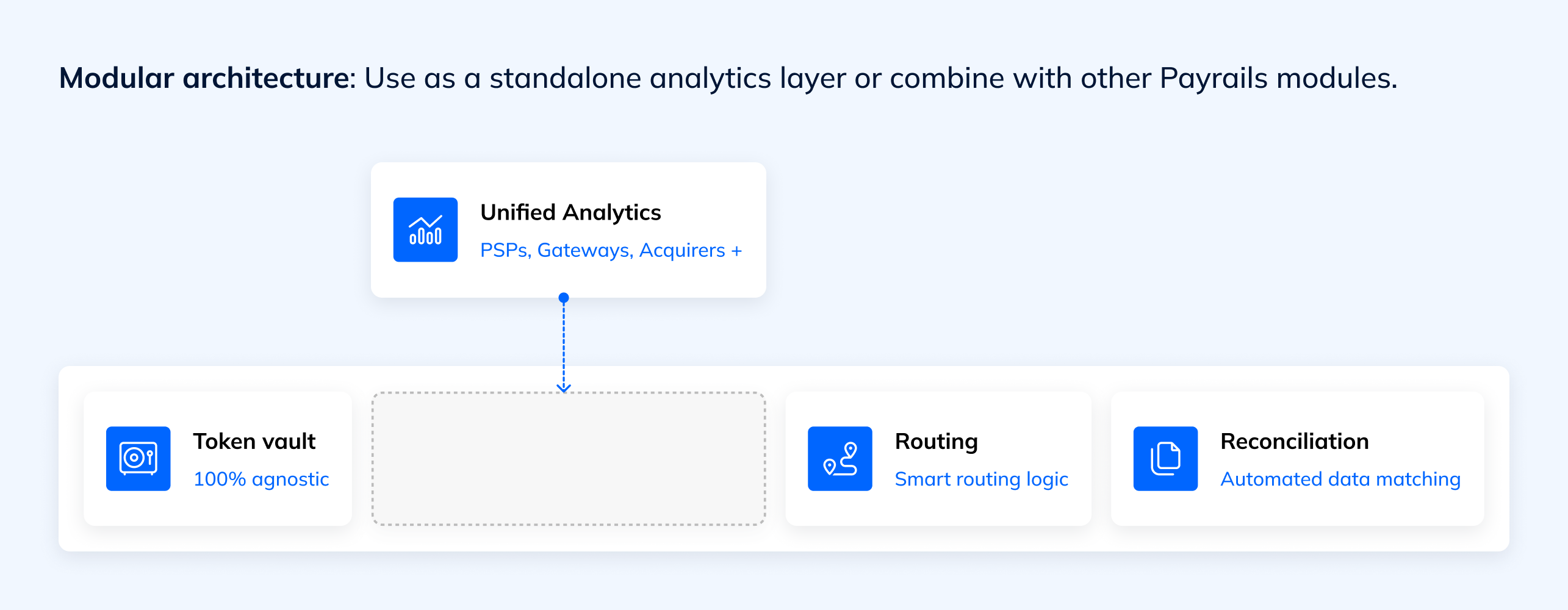
How to get started
The path to moving from fragmented reporting to unified analytics for payment optimization starts with understanding your current data gaps.
- Audit current data gaps and duplication: List every PSP dashboard you check monthly. Document which metrics don't match between providers. Identify manual processes that unified analytics could automate. This inventory often reveals surprising fragmentation – it’s not uncommon for enterprise merchants to discover their payment data scattered across more PSPs than expected.
- Define priority KPIs: Unified analytics work best when you know which insights matter most. Focus on metrics that directly impact revenue – acceptance rate, fraud rate, total payment volume, and cost per transaction. For subscription businesses, this analysis typically shows that fragmented reporting creates significant operational overhead during monthly reconciliation processes.
- Request a tailored demo with Payrails: See how unified analytics handles your specific PSP mix and transaction patterns. Payrails provides customizable dashboards and reporting tailored to each stakeholder group's specific responsibilities.
- Test with historical data or pilot environment: Validate data accuracy and reporting capabilities before full deployment. Compare unified analytics output to your current reporting to ensure consistency. Payrails' data integration approach handles the technical complexity of normalizing transaction data across multiple PSPs while maintaining transaction-level granularity.
- Deploy and measure impact: Configure automated alerts and role-based dashboards, then track improvements in fee reduction, authorization rates, and operational efficiency.
Implementation often delivers results quickly. It's not long before merchants see measurable improvements once unified analytics is deployed, like the 20% checkout conversion rate boost one team achieved through better payment performance insights. The shift from scattered dashboards to unified payment intelligence fundamentally changes how enterprise merchants operate – transforming payment data from an operational burden into a strategic edge.
Turn your payment data into a competitive advantage
In payments, every insight is a revenue opportunity – but only if you can see it.
Ready to unify your payment analytics? Contact Payrails for a demo and see how much revenue your enterprise can recover through complete payment visibility.









